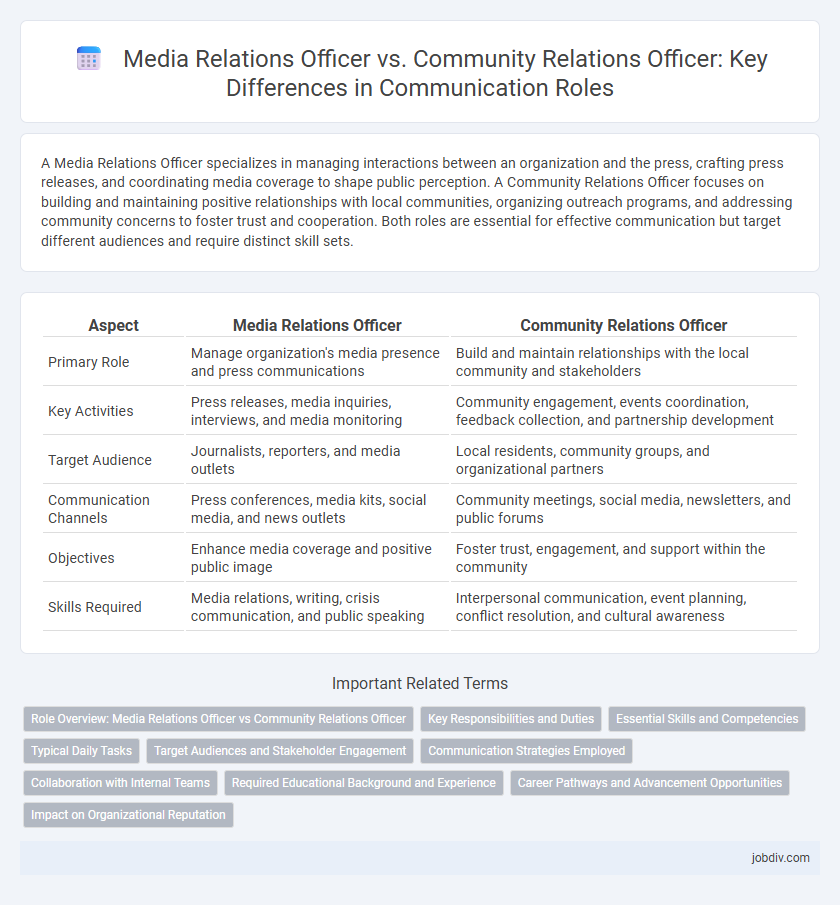A Media Relations Officer specializes in managing interactions between an organization and the press, crafting press releases, and coordinating media coverage to shape public perception. A Community Relations Officer focuses on building and maintaining positive relationships with local communities, organizing outreach programs, and addressing community concerns to foster trust and cooperation. Both roles are essential for effective communication but target different audiences and require distinct skill sets.
Table of Comparison
| Aspect | Media Relations Officer | Community Relations Officer |
|---|---|---|
| Primary Role | Manage organization's media presence and press communications | Build and maintain relationships with the local community and stakeholders |
| Key Activities | Press releases, media inquiries, interviews, and media monitoring | Community engagement, events coordination, feedback collection, and partnership development |
| Target Audience | Journalists, reporters, and media outlets | Local residents, community groups, and organizational partners |
| Communication Channels | Press conferences, media kits, social media, and news outlets | Community meetings, social media, newsletters, and public forums |
| Objectives | Enhance media coverage and positive public image | Foster trust, engagement, and support within the community |
| Skills Required | Media relations, writing, crisis communication, and public speaking | Interpersonal communication, event planning, conflict resolution, and cultural awareness |
Role Overview: Media Relations Officer vs Community Relations Officer
A Media Relations Officer manages communication between an organization and the media, crafting press releases, arranging interviews, and ensuring accurate public representation. A Community Relations Officer focuses on building and maintaining positive relationships with local communities through outreach programs, events, and direct engagement. Both roles require strong communication skills but target different audiences: media professionals versus community members.
Key Responsibilities and Duties
A Media Relations Officer manages interactions with journalists, crafts press releases, and monitors media coverage to maintain a positive public image. A Community Relations Officer focuses on building and sustaining relationships with local communities through outreach programs, events, and public feedback. Both roles require strategic communication skills but target different audiences and platforms to enhance organizational reputation.
Essential Skills and Competencies
Media Relations Officers excel in strategic communication, press release writing, and media monitoring, ensuring accurate representation of organizational messages to journalists and news outlets. Community Relations Officers demonstrate strong interpersonal skills, cultural awareness, and grassroots engagement expertise, effectively fostering trust and collaboration within diverse local populations. Both roles require crisis communication proficiency, adaptability, and excellent verbal and written communication skills to manage stakeholder relationships and enhance public perception.
Typical Daily Tasks
A Media Relations Officer manages press releases, coordinates interviews, and monitors media coverage to shape public perception and maintain the organization's reputation. A Community Relations Officer engages with local groups, organizes public events, and addresses community concerns to foster positive relationships and promote organizational goodwill. Both roles require strategic communication skills but differ in their primary audiences and interaction methods.
Target Audiences and Stakeholder Engagement
Media Relations Officers primarily engage with journalists, editors, and media outlets to shape public perception through earned and paid media coverage, targeting a broad external audience. Community Relations Officers concentrate on building trust and fostering ongoing relationships with local residents, community groups, and nonprofit organizations, emphasizing direct stakeholder engagement and grassroots involvement. Effective communication strategies require tailoring messages to each audience's unique interests and channels to maximize outreach and impact.
Communication Strategies Employed
Media Relations Officers prioritize managing relationships with journalists and media outlets to secure positive coverage through press releases, interviews, and media briefings. Community Relations Officers emphasize direct engagement with local groups, stakeholders, and residents, employing grassroots communication, public meetings, and social media to foster trust and two-way dialogue. Both roles utilize tailored messaging and strategic outreach to enhance organizational reputation and community engagement.
Collaboration with Internal Teams
Media Relations Officers coordinate closely with marketing, public relations, and executive teams to craft consistent messaging and manage media inquiries effectively. Community Relations Officers collaborate with HR, program managers, and local partners to foster community engagement and address stakeholder concerns. Both roles emphasize synergy across departments to align communication strategies and enhance organizational reputation.
Required Educational Background and Experience
A Media Relations Officer typically requires a bachelor's degree in communications, journalism, or public relations, paired with experience in media monitoring, press release writing, and managing media inquiries. A Community Relations Officer often holds a degree in public relations, social sciences, or community development, with experience in stakeholder engagement, community outreach, and event coordination. Both roles benefit from strong communication skills, but the Media Relations Officer emphasizes media-savvy expertise while the Community Relations Officer focuses on building and maintaining community partnerships.
Career Pathways and Advancement Opportunities
Media Relations Officers often advance by developing expertise in public relations, crisis communication, and strategic media planning, progressing to senior communications manager or director roles within corporate or agency settings. Community Relations Officers typically grow through experience in stakeholder engagement, grassroots advocacy, and community development, leading to leadership positions in nonprofit organizations, government agencies, or corporate social responsibility departments. Both career pathways benefit from strong networking, media literacy, and communication skills, with opportunities for specialization enhancing advancement potential.
Impact on Organizational Reputation
A Media Relations Officer directly shapes organizational reputation by managing press releases, securing media coverage, and handling crisis communication to influence public perception. In contrast, a Community Relations Officer builds reputation through grassroots engagement, fostering local partnerships, and organizing community outreach programs that enhance trust and goodwill. Both roles are essential, with media relations focusing on broad public exposure and community relations emphasizing sustained local support.
Media Relations Officer vs Community Relations Officer Infographic

 jobdiv.com
jobdiv.com